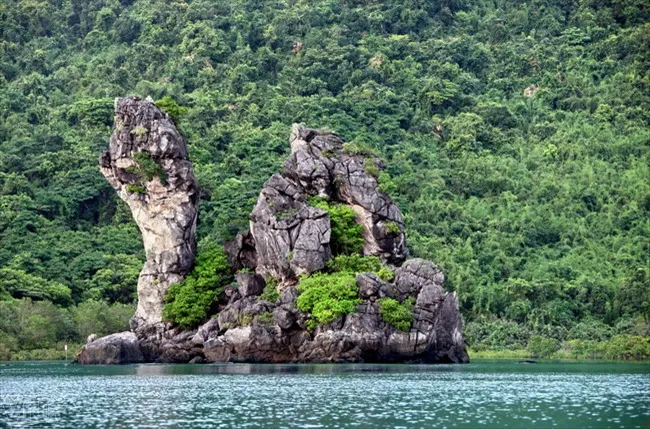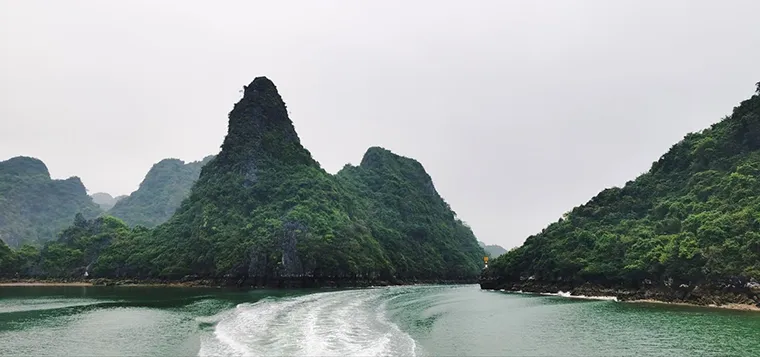Bai Tu Long National Park: Vietnam's Hidden Natural Paradise
Nestled in the northeastern region of Vietnam, Bai Tu Long National Park stands as a testament to nature's pristine beauty and remarkable biodiversity. While its neighbor, Ha Long Bay, attracts millions of tourists each year, this protected area offers a similar landscape of limestone karsts and emerald waters, but with a tranquil ambiance that invites travelers seeking a more authentic experience. Recognized as an ASEAN Heritage Park in 2017, Bai Tu Long National Park represents a significant conservation achievement and an increasingly popular ecotourism destination for those wanting to explore Vietnam's natural wonders off the beaten path.
1. An Introduction to Vietnam's Ecological Treasure
Established in January 2001, Bai Tu Long National Park evolved from the expansion and upgrade of the Ba Mun Nature Reserve, which initially covered only 2,000 hectares. Today, the park encompasses an impressive 15,783 hectares, including 6,125 hectares of land and 9,658 hectares of marine areas. Located in Quang Ninh Province in northeastern Vietnam, approximately 200 kilometers from Hanoi, the park sits adjacent to the world-famous UNESCO World Heritage Site of Ha Long Bay.
For those interested in learning more about the culture and history of the region, the Quang Ninh Museum Vietnam is also a significant attraction worth visiting in Quang Ninh Province.

Recognized as an ASEAN Heritage Park, Bai Tu Long spans 15,783 hectares of diverse land and marine ecosystems - Photo Source: tuoitrethudo
The park's recognition as an ASEAN Heritage Park in 2017 affirms its exceptional ecological value and its fulfillment of the five stringent criteria required for this prestigious designation. This accolade has elevated the park's status on the regional conservation map and highlights its importance as a biodiversity hotspot within Vietnam.
Bai Tu Long National Park is part of the larger Bai Tu Long Bay area in Van Don District. Its strategic position, east of Ha Long Bay, provides visitors with the opportunity to experience similar breathtaking landscapes with fewer crowds, making it an increasingly sought-after destination for travelers looking to escape the tourist masses while enjoying Vietnam's natural splendor.
2. Geographical Features and Ecological Diversity
2.1. Distinctive Karst Landscape
Bai Tu Long National Park features the characteristic limestone karst topography that makes this region of Vietnam world-famous. Countless islands and limestone formations rise dramatically from the emerald waters, creating a seascape of extraordinary beauty. What sets this park apart is its karst landscape's intricate features, including stone pillars, conical peaks, natural arches, and complex cave systems.
The limestone formations in the park date back millions of years to the Mesozoic era, shaped through geological processes of tectonic lifting, erosion, and deposition over extended periods. These limestone rocks formed from the accumulation and hardening of carbonate sediments on the seabed over hundreds of millions of years, followed by tectonic uplift and erosion that created the magnificent landscape seen today.

Ancient limestone formations create a dramatic seascape shaped over millions of years - Photo Source: vietnamplus
2.2. Unique "Tung Ang" Ecosystem
One of the most distinctive geographical features of Bai Tu Long is the presence of "tung ang" ecosystems—water-filled valleys nestled within limestone formations. These special ecosystems form through the mixing of seawater and freshwater, creating brackish environments ideal for the development of ancient mangrove forests. Unlike the predominantly limestone islands, Ba Mun Island is composed of slate, sand, and gravel, contributing to the park's geological diversity.
2.3. Rich Ecosystem Tapestry
Bai Tu Long National Park boasts a diverse collection of ecosystems, including tropical broadleaf evergreen forests on both soil-based and limestone mountains. The mangrove ecosystems, particularly in the Cai Lim ang area, are considered ecologically unique in Southeast Asia. Additionally, the park features seagrass beds and vibrant coral reefs, often described as the "rainforests of the sea" due to their high biodiversity.

A mix of forests, coral reefs, and wetlands sustains diverse flora and fauna - Photo Source: vietnamplus
The park also encompasses characteristic "tung ang" ecosystems, limestone mountain water-filled valley ecosystems, intertidal zones, and shallow water areas. This variety of habitats supports an impressive range of plant and animal species, making the park a biodiversity hotspot in Vietnam.
While exploring the natural beauty of this region, visitors might also be interested in visiting the Long Tien Pagoda Vietnam, a notable cultural site in Quang Ninh Province.
3. Major Attractions and Activities
3.1. Island Exploration
Bai Tu Long National Park is home to numerous captivating islands, each with its unique appeal:
Ba Mun Island - The largest island in the park, famous for its diverse ecosystem, rich animal populations, and nearly pristine primeval forests where many rare plant and animal species reside. Notably, it's the only place in northeastern Vietnam where a population of yellow sika deer still exists. Visitors can explore the island through hiking trails designed with varying levels of difficulty.

Scenic islands like Ba Mun and Tra Ngo Lon offer unique wildlife and landscapes - Photo Source: danviet
Tra Ngo Lon Island - The largest rocky island in the area, attracting visitors with its majestic beauty and the graceful Swan Rock located in Tra Than Bay. The island features a unique geological structure with soil mountains in the north and limestone mountains in the south.
Inhabited Islands like Quan Lan, Ngoc Vung, Cong Dong, and Cong Tay also serve as attractive destinations with beautiful beaches. Smaller islands such as Sau Nam, Sau Dong, and Dong Ma contribute to the park's rich island system.
3.2. Cave Systems
The cave systems within the park are another highlight that shouldn't be missed:
Bat Cave - Located in the Cai Lim area of Tra Ngo Lon Island, this cave impresses visitors with its stalactites formed by the action of seawater. It's home to thousands of bats and various other animals including monkeys, musk deer, shrimp, and fish.
Cai De Cave - With a length of approximately 300-400m, this unique location is particularly suitable for adventure-loving visitors. Access to the cave is typically only feasible during low tide, allowing small boats to venture deep inside to admire the fascinating geological formations. Notably, Cai De Cave connects with Ang Valley, which has the largest mangrove forest area in the national park.
Thien Canh Son Cave - A vast cave system with three main chambers, its entrance hidden beneath dense forest canopy near a cliff. Inside, visitors can admire strange shapes of stalactites and stalagmites resembling lotus flowers, baby elephants, seals, and various flower species. Nearby is a beach of the same name, ideal for relaxation after exploring the cave.
3.3. Pristine Beaches
Bai Chan is famous for its crystal-clear water and fine white sand, perfect for swimming and coral snorkeling. Other beaches include Tra Gioi, Cay Bang, Cat Oan, Minh Chau, Cai Lim, Hong Van, Bac Van, Van Chay, and Beach No. 1, each with its own beauty and characteristics to satisfy diverse visitor preferences.
4. Engaging Activities for Nature Enthusiasts
4.1. Water-Based Adventures
- Boat Cruising is a popular way to explore the beautiful seascape of Bai Tu Long National Park. Visitors can choose from various cruise options, from day trips to overnight journeys, typically visiting famous locations such as Thien Canh Son Cave, Vung Vieng fishing village, Ban Chan island, Cap La island, and the Cong Dam area.
- Kayaking is another favorite activity among visitors, allowing for exploration of small caves, narrow bays, and coastal areas in a more intimate way.
- Swimming and Snorkeling in the crystal-clear waters of the park's beaches provide ideal opportunities to cool off and discover the underwater world.
- Fishing attracts many visitors due to the tranquility and opportunity to experience the life of local people.
When planning your visit to Bai Tu Long National Park, consider also including a trip to Vung Vieng Fishing Village to experience the local culture and lifestyle in the Ha Long Bay area.

From boat cruising and kayaking to hiking and cultural visits, there’s much to explore - Photo Source: thanhnien
4.2. Land-Based Exploration
- Hiking trails on Ba Mun Island offer forest trekking routes with various levels, providing an excellent opportunity to explore the rich flora and fauna of the island.
- Visiting Traditional Fishing Villages such as Vung Vieng and Cong Dam allows travelers to learn about the life and culture of local communities.
- Cultural Site Visits to spiritual relics like Cua Ong Temple, Cap Tien Temple, Cai Bau Pagoda, and Quan Lan Communal House attract visitors interested in history and culture.
- Museum Exploration at the Bai Tu Long National Park Museum in Van Don District provides deeper insights into the park's ecosystems.
- Ancient Black Plum Forest on Minh Chau Island offers a unique destination with plum trees hundreds of years old.
Other activities include boat trips through Cai De Cave, camping in permitted areas (permit required), participating in wildlife conservation programs, exploring archaeological sites, birdwatching (especially in spring), coral diving, motorized water sports (at some beaches), basket boat rides, squid fishing (on some cruise tours), enjoying romantic dinners in caves or beach barbecues, visiting local markets, listening to legendary stories about the region, participating in short ecotourism courses, contributing to tree-planting activities, landscape photography, beach relaxation, sunbathing, exploring lagoons and sea caves near Cong Dam, and souvenir shopping.
5. Practical Information for Visitors
5.1. Best Time to Visit
The ideal time to visit Bai Tu Long National Park generally falls within these periods:
-
February to May and October to November - During these months, the weather is typically pleasant with moderate temperatures and low rainfall, making them ideal for exploring the park's beautiful landscapes and participating in outdoor activities.
-
Spring (March to May) - Temperatures range from 18°C to 23°C, with lush scenery, blooming flowers, and verdant trees, ideal for hiking, kayaking, swimming, and birdwatching as migratory birds return.
-
Autumn (September to November) - Offers more comfortable temperatures ranging from 20°C to 25°C, decreased rainfall, and clear blue skies, creating favorable conditions for sightseeing. Some notice the landscape turning beautifully yellow in October and November.
-
October to April - Generally recommended for international visitors due to cooler weather (15-23°C).

February to May and October to November offer the most favorable weather - Photo Source: thanhnien
Conversely, visitors should avoid visiting Bai Tu Long National Park during the period from July to September, as this is the rainy season with high temperatures, potentially affecting travel plans and outdoor activities. Summer months (May to September) can have temperatures exceeding 30°C, accompanied by high humidity and frequent rain, making outdoor exploration less enjoyable. However, many Vietnamese tourists prefer to visit Bai Tu Long Bay in June, July, and August, perhaps coinciding with summer holidays.
5.2. Transportation Options
To reach Bai Tu Long National Park from Hanoi and other locations, visitors have several transportation options:
From central Hanoi, you can take a bus or car to Hon Gai Port in Ha Long City, which takes approximately 3 hours 15 minutes, covering a distance of 136 km. Travel time from Noi Bai International Airport to Hon Gai Port is about 3 hours 20 minutes, covering 157 km by bus or car.
Alternatively, visitors can fly to Noi Bai Airport in Hanoi or Van Don Airport in Quang Ninh, then travel by motorcycle or car. For those already in the northern region, direct travel by motorcycle or car is also an option.
The final and essential leg is traveling by boat to the national park, with boat tickets from Ao Tien Port or Cai Rong Port costing around 200,000 VND per person and a high-speed boat journey taking about an hour. Another option is taking a bus or car to Quang Ninh (about 4-5 hours), then traveling by boat. Limousines also operate from Hanoi to Ha Long, providing a comfortable transportation option. Many tourists choose to take a coach from Hanoi to Quang Ninh Province (about 3 hours), then take a taxi to Bai Tu Long. Cruise companies often provide transportation services to Hon Gai Port, the departure point for cruises to Bai Tu Long.
5.3. Entrance Fees and Boat Costs
Visitors should be aware of certain fees and costs. The entrance fee for Bai Tu Long Bay (including the National Park) is 240,000 VND for a four-hour trip and 540,000 VND for an overnight trip. Additionally, there is a public boat fee of approximately 350,000 VND per person.

Buses, private cars, and boats connect Hanoi to Bai Tu Long National Park - Photo Source: thanhnien
For more privacy and flexibility, visitors can rent private boats with prices ranging from 500,000 VND to 700,000 VND per hour. Costs for cruise tours can vary depending on the type (day tour, overnight tour, luxury tour) and the specific tour operator. For example, a half-day group cruise tour might cost around 1,550,000 VND (approximately 60 euros) per person, while a full-day private cruise tour could cost around 400 euros for the entire boat. Private boat tickets to Bai Tu Long National Park from Ao Tien Port or Cai Rong Port cost approximately 200,000 VND per person, with a travel time of about one hour by high-speed boat.
5.4. Essential Tips for Visitors
For a safe, enjoyable, and responsible visit to Bai Tu Long National Park, visitors should follow these guidelines and regulations:
-
Sun Protection - Always wear a hat and apply sunscreen to protect your skin from the harmful effects of the sun.
-
Insect Repellent - Bring insect repellent, band-aids, and necessary personal medications.
-
Photography Equipment - Prepare cameras or smartphones to capture beautiful moments.
-
Weather and Traffic Checks - Check weather and traffic conditions before your trip.
-
Advance Bookings - Book hotel accommodations and tours in advance, especially during peak season.
-
Water Activity Essentials - If planning to participate in water activities, bring necessary items like waterproof bags and swimwear.
-
Accessories - Carry sunglasses, hats, umbrellas, and comfortable walking shoes.
-
Local Currency - Prepare cash in Vietnamese dong for local shopping activities.
-
Local Guide - Consider hiring a local guide for a better-prepared journey and deeper understanding of the area.
-
Appropriate Clothing - When exploring the park, wear light, breathable clothing and sturdy hiking shoes or water-resistant footwear.
-
Electronics Protection - Protect electronic devices in waterproof bags due to numerous water-related activities.
-
Rain Gear - Bring rain jackets or ponchos in case of unexpected rain.
-
Motion Sickness Medication - If prone to seasickness, prepare motion sickness medication for boat journeys.
-
Wildlife Respect - Respect wildlife by maintaining a safe distance and not feeding them.
-
Environmental Practices - Follow environmentally friendly behaviors such as proper waste disposal, avoiding littering, and carrying away your trash to help preserve the park's pristine natural environment.
-
Local Guidelines - Follow local guidelines and respect protected areas to help maintain the park's sensitive ecosystems.
-
Hydration - Stay hydrated by bringing plenty of drinking water and snacks, as shops may not be readily available in remote areas of the park.
-
Respectful Dress - When visiting spiritual relics, dress modestly by covering shoulders and knees.
-
Camping Regulations - For those interested in camping, check park regulations and obtain necessary permits.
-
Cave Exploration Safety - Wear hiking shoes when exploring caves and take necessary safety precautions.
-
Avoid Rainy Season - Generally avoid visiting the park during the rainy typhoon season from July to September.
6. Conclusion
Bai Tu Long National Park stands as a testament to the extraordinary natural beauty and rich biodiversity of Vietnam's northeastern coastal region. Its spectacular limestone landscape, similar to the famous Ha Long Bay, is complemented by unique ecosystems such as "tung ang," supporting a remarkable array of plant and animal life, including many rare and endangered species. The park's recognition as an ASEAN Heritage Park underscores its regional ecological importance.
As tourism continues to develop in the region, it is crucial to prioritize sustainable activities within Bai Tu Long National Park. This includes encouraging responsible tourism behavior to minimize environmental impact, supporting local communities and businesses committed to sustainable development, and strictly adhering to park regulations and guidelines designed to protect its natural and cultural resources.
|
Joytime Travel Agency - Travel JOY, TIMEless Vietnam Follow us for travel tips, local insights, and exclusive offers:
|

Danish Nguyen
Danish Nguyen is a renowned travel blogger in Vietnam with over 5 years of experience sharing unique travel experiences. With a passion for exploring new places, Danish captures incredible moments and provides readers with valuable tips to discover the beauty of his homeland.








.webp)
.webp)








